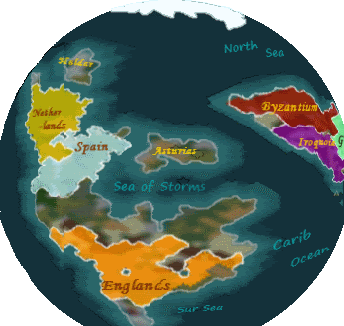C3C, continents, hot seat, 70% ocean, raging barbs

Global: An Experiment in Negative Capability
Table of Contents (for speedy navigation to the good parts) - Ch 1-31 Updated 14 July 2010
Spoiler :
Fourth Millennium BCC
Chapter One: The Tribes of Atlan
Chapter Two: The Tribes of Euria
Chapter Three: The Tribes of Pacifika
Third Millennium BCC
Chapter Four: Iroquoia
Chapter Five: England
Chapter Six: Netherlands
Chapter Seven: America
Chapter Eight: Gaul
Chapter Nine: Japan
Chapter Ten: Byzantium
Chapter Eleven: Spain
Second Millennium BCC
Ch 12: Carved Words - Iroquoia
Ch 13: First Dynasties - Iroquoia
Ch 14: Bronze and Gold - England
Ch 15: English Iron Age - England
Ch 16: A Peaceful Race - Netherlands
Ch 17: Devil & the Deep - Pacifika
Ch 18: Growing Up - Pacifika
Ch 19: Decline & Fall - Pacifika
Ch 20: Dawn of the Eastern Iron Age - Euria
Ch 21: The Omphalic Land - Spain
Ch 22: The Heroic Expansion - Spain
First Millennium BCC
Ch 23: Troubles with Barbarians - Atlan
Ch 24: Laws and Ideas - Atlan
Ch 25: The Council and the Sage - Atlan
Ch 26: The Circle of Strife - Euria
Ch 27: Tyrannic Prosperity - Euria
Ch 28: Cathaoirs at the Gate - Euria
Ch 29: Goddess of War - Euria
Ch 30: The Last Samurai - Pacifika
Ch 31: Barb on Barb Violence - Pacifika
Chapter One: The Tribes of Atlan
Chapter Two: The Tribes of Euria
Chapter Three: The Tribes of Pacifika
Third Millennium BCC
Chapter Four: Iroquoia
Chapter Five: England
Chapter Six: Netherlands
Chapter Seven: America
Chapter Eight: Gaul
Chapter Nine: Japan
Chapter Ten: Byzantium
Chapter Eleven: Spain
Second Millennium BCC
Ch 12: Carved Words - Iroquoia
Ch 13: First Dynasties - Iroquoia
Ch 14: Bronze and Gold - England
Ch 15: English Iron Age - England
Ch 16: A Peaceful Race - Netherlands
Ch 17: Devil & the Deep - Pacifika
Ch 18: Growing Up - Pacifika
Ch 19: Decline & Fall - Pacifika
Ch 20: Dawn of the Eastern Iron Age - Euria
Ch 21: The Omphalic Land - Spain
Ch 22: The Heroic Expansion - Spain
First Millennium BCC
Ch 23: Troubles with Barbarians - Atlan
Ch 24: Laws and Ideas - Atlan
Ch 25: The Council and the Sage - Atlan
Ch 26: The Circle of Strife - Euria
Ch 27: Tyrannic Prosperity - Euria
Ch 28: Cathaoirs at the Gate - Euria
Ch 29: Goddess of War - Euria
Ch 30: The Last Samurai - Pacifika
Ch 31: Barb on Barb Violence - Pacifika
Introduction (boring)
Spoiler :
 I'm obsessed with this game. I want to see it be more like real history. The difference between real history and Civ 3 is that in Civ 3 you only get to see the world from one nation's vantage point. So this is also an experiment in seeing a Civ 3 planet's history from a global perspective. I've known time and again what it looks like from my point of view. This is an attempt to see it objectively by using multiplayer mode.
I'm obsessed with this game. I want to see it be more like real history. The difference between real history and Civ 3 is that in Civ 3 you only get to see the world from one nation's vantage point. So this is also an experiment in seeing a Civ 3 planet's history from a global perspective. I've known time and again what it looks like from my point of view. This is an attempt to see it objectively by using multiplayer mode.  Of course most modern philosophers and cognitive psychologists will tell you there is no way to see something objectively—that is, to see something is inherently a subjective process. So instead I try here to see the world as Sid Meier recreated it, but see from eight different subjective points of view. In each case, then, it's necessary to maintain my separate subjectivities, to try and not see this world through my own eyes, what John Keats called 'negative capability,' to immerse into each of the eight civilizations own uncertainties and limitations.
Of course most modern philosophers and cognitive psychologists will tell you there is no way to see something objectively—that is, to see something is inherently a subjective process. So instead I try here to see the world as Sid Meier recreated it, but see from eight different subjective points of view. In each case, then, it's necessary to maintain my separate subjectivities, to try and not see this world through my own eyes, what John Keats called 'negative capability,' to immerse into each of the eight civilizations own uncertainties and limitations.  So this is one story, but it is also eight stories. Or it is one story about my own ability to not be. Also, it has pictures.
So this is one story, but it is also eight stories. Or it is one story about my own ability to not be. Also, it has pictures.
Map, 200 BCC
Spoiler :
200 BCC

1300 BCC

3000 BCC


1300 BCC

3000 BCC

Comments welcome. Can you guess who's going to win yet?





































 ...These natives deserved it, however.
...These natives deserved it, however.





 They finished them off by 2000bc.
They finished them off by 2000bc.























